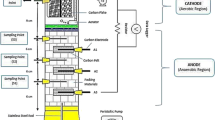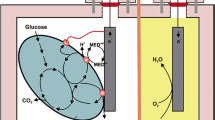Abstract
This study obtained the maximum pollutant reduction and power production from the dairy industry wastewater using double-chambered salt bridge microbial fuel cell by the Taguchi method. The maximum removal of chemical oxygen demand from dairy industry wastewater was found to be 89.7% in double-chambered salt bridge microbial fuel cell. Similarly, the current, voltage, power, current density and power density obtained in double-chambered salt bridge microbial fuel cell from dairy industry wastewater were 17.28 mA, 815.32 mV, 14.09 mW, 1309.09 mA/m2 and 1067.33 mW/m2, respectively. The maximum removal of chemical oxygen demand and power production was observed for the process parameters viz., 1 M KCl concentration, 10% agarose concentration, and 0.05 m salt bridge. It may be pointed out from the analysis of variance that the order of prevailing process parameters was agarose concentration followed by KCl molar concentration and salt bridge length for getting the maximum pollutants reduction and power production from dairy industry wastewater using double-chambered salt bridge microbial fuel cell. The other pollutants viz., TSS, TDS, BOD, COD, nitrate, phosphate, sulphate, chloride, ammonia, and oil and grease in a dairy industry wastewater also reduced to the maximum for the best-optimized process parameters of 1 M KCl concentration, 10% agarose concentration, and 0.05 m salt bridge. The regression model obtained in this study was utilized to select the appropriate combination of process parameters for obtaining the required maximum reduction of pollutants and simultaneous power production. Thus, this study suggested that double-chambered salt bridge microbial fuel cell can be performed well for maximum pollutant reduction and simultaneous power production for the appropriate process parameters value from any wastewater.
Graphic abstract









Similar content being viewed by others
Abbreviations
- A :
-
Surface area
- ANOVA:
-
Analysis of variance
- APHA:
-
American Public Health Association
- BOD:
-
Biochemical oxygen demand
- CD:
-
Current density
- C i :
-
Initial concentration
- C o :
-
Final concentration
- COD:
-
Chemical oxygen demand
- DCSB-MFC:
-
Double-chambered salt bridge microbial fuel cell
- HCl:
-
Hydrochloric acid
- I :
-
Current
- K3Fe(CN)6 :
-
Potassium ferricyanide
- KCl:
-
Potassium chloride
- KNO3 :
-
Potassium nitrate
- MFC:
-
Microbial fuel cell
- NaCl:
-
Sodium chloride
- NaOH:
-
Sodium hydroxide
- P :
-
Power
- PD:
-
Power density
- R 2 :
-
Coefficient of determination
- S/N ratio:
-
Signal-to-noise ratio
- TDS:
-
Total dissolved solids
- TSS:
-
Total suspended solids
- V :
-
Voltage
References
Aishwarya DD, Neha M, Omkar AS, Pallavi TK (2011) Microbial fuel cell for production of bioelectricity from whey and biological waste treatment. Int J Adv Biotechnol Res 2(2):263–268
Al-Wasify RS, Ali MN, Hamed SR (2017) Biodegradation of dairy wastewater using bacterial and fungal local isolates. Water Sci Technol 76(11):3094–3100
Amrita S, Rai BN, Singh RS (2017) A comparative study of a biofuel cell with two different proton exchange membrane for the production of electricity from wastewater. Resour-Eff Technol 3:78–81
APHA (2017) Standard methods for the examination of water and wastewater, 23rd edn. American Public Health Association, Washington DC
Asensio Y, Fernandez-Marchante CM, Lobato J, Cañizares P, Rodrigo MA (2018) Influence of the ion-exchange membrane on the performance of double compartment microbial fuel cells. J Electroanal Chem 808:427–432
Boas JV, Oliveira VB, Marcon LRC, Pinto DP, Simoes M, Pinto AMFR (2015) Effect of operating and design parameters on the performance of a microbial fuel cell with Lactobacillus pentosus. Biochem Eng J 104:34–40
Chae KJ, Choi M, Ajayi FF, Park W, Chang IS, Kim IS (2008) Mass transport through a proton exchange membrane (Nafion) in microbial fuel cells. Energy Fuels 22:169–176
Dalvi AD, Mohandas N, Shinde O, Kininge PT (2011) Microbial fuel cell for production of bioelectricity from whey and biological waste treatment. Int J Adv Biotech Res 2:263–268
Fatemi S, Ghoreyshi AA, Najafpour G, Rahimnejad M (2012) Less microbial fuel cell: application of pure and mixed cultures bioelectricity generation in mediator. Iran J Energy Environ 3(2):104–108
Garcha S, Verma N, Brar SK (2016) The isolation, characterization and identification of microorganisms from unorganized dairy sector wastewater and sludge samples and evaluation of their biodegradability. Water Resour Ind 16:19–28
Jatoi AS, Mahar H, Aziz S, Furqan SM, Malik AA, Hussain S, Kakar E (2016) To investigate the optimized conditions of salt bridge for bio-electricity generation from distillery wastewater using microbial fuel cell. NUST J Eng Sci 9(2):29–34
Jimenez IM, Juarez FG, Greenman J, Leropoulos L (2019) Effect of the ceramic membrane properties on the microbial fuel cell power output and catholyte generation. J Power Sources 429:30–37
Khan MR, Bhattacharjee R, Amin MSA (2012) Performance of the salt bridge based microbial fuel cell. Int J Eng Technol 1(2):115–123
Khare AP, Bundela H (2013) Generation of electricity using vermicompost with different substrates through single chamber MFC approach. Int J Eng Trends Technol 4(9):4206–4210
Kishimoto N, Hachiro H, Fukunaga H, Yoshioka N, Murakami Y (2013) Effect of active control of air cathode pH on the performance of a microbial fuel cell. J Water Environ Technol 11:453–461
Kolev Slavov A (2017) Dairy wastewater treatment review. Food Technol Biotechnol 55(1):14–28
Kumar P, Mungray AK (2016) Microbial fuel cell: optimizing pH of anolyte and catholyte by using Taguchi method. Environ Progr Sustain Energy 36(1):120–128
Lai MF, Lou CW, Li JH (2018) Improve 3D electrode materials performance on electricity generation from livestock wastewater in microbial fuel cell. Int J Hydrogen Energy 43(25):11520–11529
Li XM, Cheng KY, Wong JW (2013) Bioelectricity production from food waste leachate using microbial fuel cells: effect of NaCl and pH. Biores Technol 149:452–458
Mahendra BG, Mahavarkar S (2013) Treatment of wastewater and electricity generation using microbial fuel cell technology. Int J Res Eng Technol 3(4):277–282
Muthukumar M, Shanmuga Priya S, Sangeetha T (2014) Impact of salt on bioelectricity generation in a dual-chambered microbial fuel cell using sago-processing wastewater. Iran J Energy Environ 5(4):376–386
Parkash A, Aziz S, Abro M, Kousar A, Soomro SA, Jatoi ST (2015) Impact of agarose concentrations on electricity generation using hostel sludge based duel chambered microbial fuel cell. Sci Int (Lahore) 27(2):1057–1061
Patade S, Silveira K, Babu A, D’Costa F, Mhatre Y, Saini V, Rajput R, Mathew J, Radhika BR, Aruna K (2016) Bioremediation of dye effluent waste through an optimized microbial fuel cell. Int J Adv Res Biol Sci 3(5):214–226
Patel R, Zaveri P, Munshi NS (2019) Microbial fuel cell, the Indian scenario: developments and scopes. Biofuels 10(1):101–108
Rahimnejad M, Bakeri G, Ghasemi M, Zirepour A (2014) A review on the role of proton exchange membrane on the performance of microbial fuel cell. Polym Adv Technol 25(12):1426–1432
Sarma D, Thakuria M, Dey N, Nath S, Barua PB, Mallick S (2019) Investigation and Taguchi optimization of microbial fuel cell salt bridge dimensional parameters. J Inst Eng (India): Ser C 100(1):103–112
Shankar R, Mondal P, Chand S (2015) Simultaneous generation of electricity and removal of organic load from synthetic wastewater in a membrane less microbial fuel cell: parametric evaluation. Environmental Progress and Sustainable Energy 34(1):255–264
Shashikant RM, Vandana VM (2017) Treatment of blended wastewater using single chamber and double chambered MFC. International Journal of Engineering Science Invention 6(2):54–59
Singh HM, Pathak AK, Chopra K, Tyagi VV, Anand S, Kothari R (2019) Microbial fuel cells: a sustainable solution for bioelectricity generation and wastewater treatment. Biofuels 10(1):11–31
Sivakumar D (2015) Hexavalent chromium removal in a tannery industry wastewater using rice husk silica. Global Journal of Environmental Science and Management 1(1):27–40
Sivakumar D (2016) Biosorption of hexavalent chromium in a tannery industry wastewater using fungi species. Global Journal of Environmental Science and Management 2(2):105–124
Sivakumar D (2020) Pollution reduction and electricity production from dairy industry wastewater with microbial fuel cell. Global J. Environ. Sci. Manage. 6(2):145–164
Sowmyashree SS, Udayashankara TH (2018) Treatment of dairy wastewater and bioelectricity generation using membrane less microbial fuel cell. International Journal of Civil Engineering and Technology 9(5):679–685
Sun G, Thygesen A, Ale MT, Mensah M, Poulsen FW, Meyer AS (2014) The significance of the initiation process parameters and reactor design for maximizing the efficiency of microbial fuel cells. Appl Microbiol Biotechnol 98:2415–2427
Zang C, Liang P, Jiang Y, Huang X (2015) Enhanced power generation of microbial fuel cell using manganese dioxide-coated anode in flow-through mode. J Power Sources 273:580–583
Zerrouki A, Kameche M, Kebaili H, Boukoussa IS, Flitti MA, Ilikti H (2018) An investigation on polymer ion exchange membranes used as separators in low-energy microbial fuel cells. Polym Bull 75(11):4947–4965
Acknowledgements
The author acknowledges the financial and technical supports extended from Vel Tech High Tech Dr. Rangarajan Dr. Sakunthala Engineering College, Chennai, Tamil Nadu, India, for carrying out the research work. The author also wish to thank the Director, Ambattur Dairy Products, Chennai, Tamil Nadu, for providing dairy industry wastewater to carry out this study.
Author information
Authors and Affiliations
Corresponding author
Ethics declarations
Conflict of interest
The authors declare that they have no conflict of interest.
Additional information
Editorial responsibility: M. Abbaspour.
Electronic supplementary material
Below is the link to the electronic supplementary material.
Rights and permissions
About this article
Cite this article
Sivakumar, D. Wastewater treatment and bioelectricity production in microbial fuel cell: salt bridge configurations. Int. J. Environ. Sci. Technol. 18, 1379–1394 (2021). https://doi.org/10.1007/s13762-020-02864-0
Received:
Revised:
Accepted:
Published:
Issue Date:
DOI: https://doi.org/10.1007/s13762-020-02864-0




